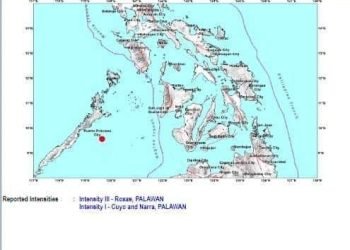Parts of Cleopatra’s Needle Critical Habitat (CNCH), the mountains in the northern portion of Puerto Princesa City that is home to 85% of the island’s endemic birds and mammals, was heavily damaged two years ago due to the fury of Typhoon Odette that toppled towering trees, eroded portions of land, and wreaked havoc to both humans and nature. This caused damages to vital infrastructures and agriculture and disrupted economic and social activities.
Typhoon Odette made people realize the importance of our environment. Neglecting them made us vulnerable during the occurrence of natural calamities.
The International Union for Conservation of Nature (IUCN) said that forests help stabilize the climate. The mountain and the forest trees play a big role when it comes to water cycle because they are the ones absorbing it. Forests shall be taken care of.
It appears that the iconic Cleopatra’s Needle, Puerto Princesa’s highest peak at 1,593 meters above sea level, plays a key role in mitigating climate change threats and natural catastrophes.
Recognizing the importance of CNCH, the City Government of Puerto Princesa and Palawan Council for Sustainable Development (PCSD) intensified its action to adopt the current management scheme provided in the management plan in an effort to ensure continuity in the management and administration of the critical habitat.
Through the signing of Memorandum of Agreement (MOA), its commitment to protect and conserve CNCH was cemented.
The MOA stipulates that the PCSD through the PCSDS shall exercise oversight function in the management, operation and protection of CNCH, provide technical support and/or technical staff as may be necessary, and conduct regular monitoring.
The City Government on the other hand, must provide the budget for the management, operation and protection of CNCH, and enact the necessary ordinances and other policies for the protection, conservation, and management of CNCH.
The MOA provides that a Manual of Operations providing the rules and procedures governing the conduct of business of the CNCH Management Board shall be prepared and adopted. It also provides that CNCH management office shall be established, which shall be responsible for the establishment of a management office to be headed by a manager for the day-to-day management, protection and administration of the critical habitat.
City Mayor Lucilo R. Bayron underscores the importance of the CNCH not only for the City but for the entire Palawan, being among the oldest and most biodiverse in the country.
“The City of Puerto Princesa is happy to partner with PCSD in protecting and managing CNCH, because we are aware that we cannot do it alone. CNCH is very precious to Puerto Princesa and Palawan,” he declared.
He lauded City Environment and Natural Resources Office (City ENRO), the City Planning and Development Office, and the Technical Working Group (TWG) with the support of the USAID-Protect Wildlife project for facilitating the formulation of the management plan.
Atty. Carlo B. Gomez, the City Environment and Natural Resources Officer (City ENRO) of Puerto Princesa emphasized the duties and responsibilities of the city government, especially in integrating environment in local development plans, implement environmental protection programs, among others, as he said that the MOA signing is considered as the most successful point of performing that responsibility.
“The City Government of Puerto Princesa is mandated to integrate environmental aspects in local development plans. Its duty to implement environmental protection program is coupled with a responsibility to enforce environmental laws and regulation and in furtherance of this mandate the City of Puerto Princesa has consistently inclined its efforts in establishing biodiversity hotspots and protected areas thus the establishment has supports to the creation of CNCH in its priority programs,” Atty. Gomez said.
“Now is the pinnacle of that responsibility,” he declared. Governor Victorino Dennis Socrates said that protection and conservation of the environment and CNCH is a duty of all.
“We are stewards of this beautiful province that God has entrusted to us and we carry this responsibility. Protecting the CNCH is necessary for the perpetuation of wildlife habitat species or otherwise be lost due to extinction,” Governor Socrates said.
It was six years ago, or in December 2017, when PCSD declared the areas within Cleopatra’s Needle Forest Reserve as Critical Habitat pursuant to Republic Act 9147, also known as Wildlife Resources Conservation and Protection Act.
Since then, the City Government exercised measures to establish the effective and efficient management of the area including initiatives for the formulation of the current management plan.
Mayor Bayron issued executive orders creating the CNCH interim management board and later the CNCH management board, a multi-sectoral body co-chaired by the PCSD and the City Government, with members representing government agencies, non-government organizations, academe, people’s organization within the CNCH, indigenous peoples (IP) community, among others, ensuring transparent and participatory governance.
On January 30, 2023, the Sangguniang Panlungsod of Puerto Princesa enacted Ordinance No. 1191 adopting PCSD Resolution No. 17-612. RA 9147 has mandated that all designated critical habitats shall be protected in coordination with the local government units (LGUs) and other concerned groups from any form of exploitation or destruction, which may be detrimental to the survival of the threatened species dependent thereon.
In a report prepared by the Forest Management Services Division of the City ENRO, they identified three priority threatened species within CNCH, including Palawan Paangolin (Manis culionensis) locally known as balintong and is considered as the most trafficked mammal in the world, Palawan Bearcat (Artictis binturong whitei), a mammal endangered and endemic to Palawan, and the resin or bagtik of Almaciga (Agathis philippinensis Warb.) which is the primary source of livelihood of Batak and Tagbanua indigenous communities.
A report by the United States Agency for International Development’s Philippine Sustainable Interventions for Biodiversity, Oceans, and Landscapes (USAID SIBOL) project, elucidates just how devastating Odette was, particularly for the forests north of Puerto Princesa.
In CNCH, “Fifty percent (50 percent) or 15,728 ha of forests were reduced into open forests or non-forest overnight.”
The report said that Typhoon Odette’s toll on biodiversity has been tremendous and the long-term survival of some wildlife in Puerto Princesa’s forest has been compromised, aside from the wildlife, the mighty Almaciga (Agathis philippinensis) too, which holds profound economic importance not just for the island’s ecosystems but for its indigenous peoples.
Gideon Lasco, a medical anthropologist, said that Palawan’s forests “carry the imprint and the yet unhealed scars of a devastating supertyphoon: One whose after effects linger, further threatening the already imperiled ecosystems of one of the most beautiful and biodiverse islands in the world.”
CNCH encompasses 41,350 hectares comprising of seven barangays of San Rafael, Tanabag, Concepcion, Binduyan, Langogan, Tagabinet and New Panggangan.
CNCH is synonymous to Puerto Princesa and the communities living within the area, as depicted in oral traditions, stories, songs, and local tales especially among the indigenous peoples. Aside from being an anchor of a vast number of ecosystems supporting a megadiverse number of species, it can also mitigate the effects natural calamities, landslides, and other threats if protected and conserved properly and sustainably. The strengthening of the management within CNCH by the City Government of Puerto Princesa, PCSD, and other stakeholders, is a testament that the present generation of Puerto Princesans treasure CNCH as an heirloom that they can pass on to the next generations.




















Discussion about this post